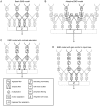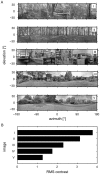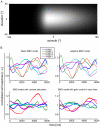Pattern-dependent response modulations in motion-sensitive visual interneurons--a model study
- PMID: 21760894
- PMCID: PMC3132178
- DOI: 10.1371/journal.pone.0021488
Pattern-dependent response modulations in motion-sensitive visual interneurons--a model study
Abstract
Even if a stimulus pattern moves at a constant velocity across the receptive field of motion-sensitive neurons, such as lobula plate tangential cells (LPTCs) of flies, the response amplitude modulates over time. The amplitude of these response modulations is related to local pattern properties of the moving retinal image. On the one hand, pattern-dependent response modulations have previously been interpreted as 'pattern-noise', because they deteriorate the neuron's ability to provide unambiguous velocity information. On the other hand, these modulations might also provide the system with valuable information about the textural properties of the environment. We analyzed the influence of the size and shape of receptive fields by simulations of four versions of LPTC models consisting of arrays of elementary motion detectors of the correlation type (EMDs). These models have previously been suggested to account for many aspects of LPTC response properties. Pattern-dependent response modulations decrease with an increasing number of EMDs included in the receptive field of the LPTC models, since spatial changes within the visual field are smoothed out by the summation of spatially displaced EMD responses. This effect depends on the shape of the receptive field, being the more pronounced--for a given total size--the more elongated the receptive field is along the direction of motion. Large elongated receptive fields improve the quality of velocity signals. However, if motion signals need to be localized the velocity coding is only poor but the signal provides--potentially useful--local pattern information. These modelling results suggest that motion vision by correlation type movement detectors is subject to uncertainty: you cannot obtain both an unambiguous and a localized velocity signal from the output of a single cell. Hence, the size and shape of receptive fields of motion sensitive neurons should be matched to their potential computational task.
Conflict of interest statement
Figures







Similar articles
-
Localized direction selective responses in the dendrites of visual interneurons of the fly.BMC Biol. 2010 Apr 12;8:36. doi: 10.1186/1741-7007-8-36. BMC Biol. 2010. PMID: 20384983 Free PMC article.
-
Neural mechanism underlying complex receptive field properties of motion-sensitive interneurons.Nat Neurosci. 2004 Jun;7(6):628-34. doi: 10.1038/nn1245. Epub 2004 May 9. Nat Neurosci. 2004. PMID: 15133514
-
Local and global responses of insect motion detectors to the spatial structure of natural scenes.J Vis. 2011 Dec 27;11(14):20. doi: 10.1167/11.14.20. J Vis. 2011. PMID: 22201615
-
Fly motion vision.Annu Rev Neurosci. 2010;33:49-70. doi: 10.1146/annurev-neuro-060909-153155. Annu Rev Neurosci. 2010. PMID: 20225934 Review.
-
Towards Computational Models and Applications of Insect Visual Systems for Motion Perception: A Review.Artif Life. 2019 Summer;25(3):263-311. doi: 10.1162/artl_a_00297. Artif Life. 2019. PMID: 31397604 Review.
Cited by
-
Facilitation of dragonfly target-detecting neurons by slow moving features on continuous paths.Front Neural Circuits. 2012 Oct 29;6:79. doi: 10.3389/fncir.2012.00079. eCollection 2012. Front Neural Circuits. 2012. PMID: 23112764 Free PMC article.
-
Neuronal encoding of object and distance information: a model simulation study on naturalistic optic flow processing.Front Neural Circuits. 2012 Mar 21;6:14. doi: 10.3389/fncir.2012.00014. eCollection 2012. Front Neural Circuits. 2012. PMID: 22461769 Free PMC article.
-
Path integration and optic flow in flying insects: a review of current evidence.J Comp Physiol A Neuroethol Sens Neural Behav Physiol. 2025 May;211(3):375-401. doi: 10.1007/s00359-025-01734-9. Epub 2025 Mar 7. J Comp Physiol A Neuroethol Sens Neural Behav Physiol. 2025. PMID: 40053081 Free PMC article. Review.
-
Temporal statistics of natural image sequences generated by movements with insect flight characteristics.PLoS One. 2014 Oct 23;9(10):e110386. doi: 10.1371/journal.pone.0110386. eCollection 2014. PLoS One. 2014. PMID: 25340761 Free PMC article.
-
Texture-defined objects influence responses of blowfly motion-sensitive neurons under natural dynamical conditions.Front Integr Neurosci. 2014 Apr 29;8:34. doi: 10.3389/fnint.2014.00034. eCollection 2014. Front Integr Neurosci. 2014. PMID: 24808836 Free PMC article.
References
-
- Lappe M. Neuronal Processing of Optic Flow. Elsevier. 1999;44
-
- Egelhaaf M. The neural computation of visual motion information. Invertebrate Vision. 2006. pp. 399–461.
-
- Reichardt W. Autocorrelation, a principle for the evaluation of sensory information by the central nervous system. In: Rosenblith WA, editor. Sensory Communication. M.I.T. Press; Wiley, J.& Sons; 1961. pp. 303–317.
-
- Egelhaaf M, Borst A, Reichardt W. Computational structure of a biological motion-detection system as revealed by local detector analysis in the fly's nervous system. Journal of the Optical Society of America A: Optics and Image Science. 1989;6:1070–1087. - PubMed
-
- Egelhaaf M, Borst A. Movement detection in arthropods. Reviews of Oculomotor Research. 1993;5:53–77. - PubMed
Publication types
MeSH terms
LinkOut - more resources
Full Text Sources

